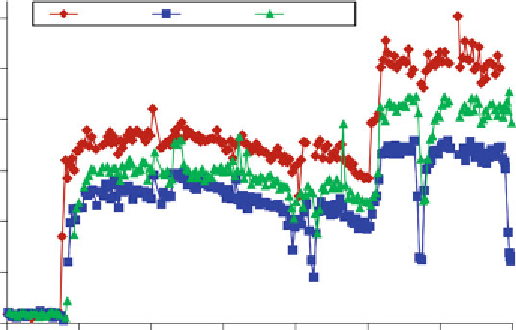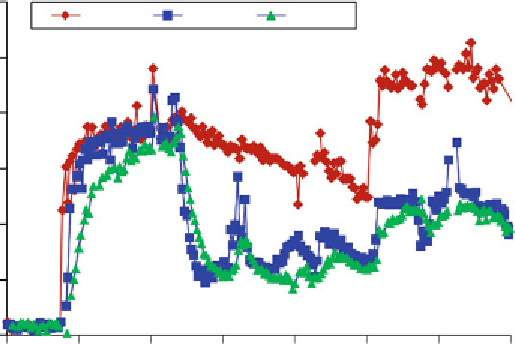Biomedical Engineering Reference
In-Depth Information
a
Bioaugmented East Leg
180
InjEast
S1East
S3East
150
120
90
60
30
0
0
10
20
30
40
50
60
70
Time (days)
b
Indigenous West Leg
InjWest
S1West
S3West
180
150
120
90
60
30
0
0
10
20
30
40
50
60
70
Time (days)
Figure 8.8. 1,1,1-TCA concentrations in the second season of testing with the butane-utilizing
Rhodococcus sp. culture (adapted from Semprini et al.,
2009
). The east leg was bioaugmented on
day 24, while both legs were fed butane and dissolved oxygen.
(named 179BP and 183BP) that could cometabolize 1,1,1-TCA and 1,1-DCE. Batch tests indicated
that 1,1-DCE was more rapidly transformed than 1,1,1-TCA by both strains, with 183BP being the
most effective organism (Semprini et al.,
2009
). Tests were repeated in the two test legs used
previously in the first season of testing using a similar protocol. 1,1,1-TCA was injected at
concentrations ranging from 80 to 140
m
g/L in both legs and 1,1-DCE was present as a
background contaminant at concentrations ranging from 4 to 12
m
g/L. Hydrogen peroxide
also was added to increase the dissolved oxygen concentration in the treatment zone and to
permit more butane to be added. The pulsed averaged injected butane concentration ranged
from 4 to 8 mg/L.
Figure
8.8
shows the results from the monitoring wells for the bioaugmented leg (top) and
indigenous leg (bottom) for 1,1,1-TCA. Butane (not shown) was observed to increase to


Search WWH ::

Custom Search